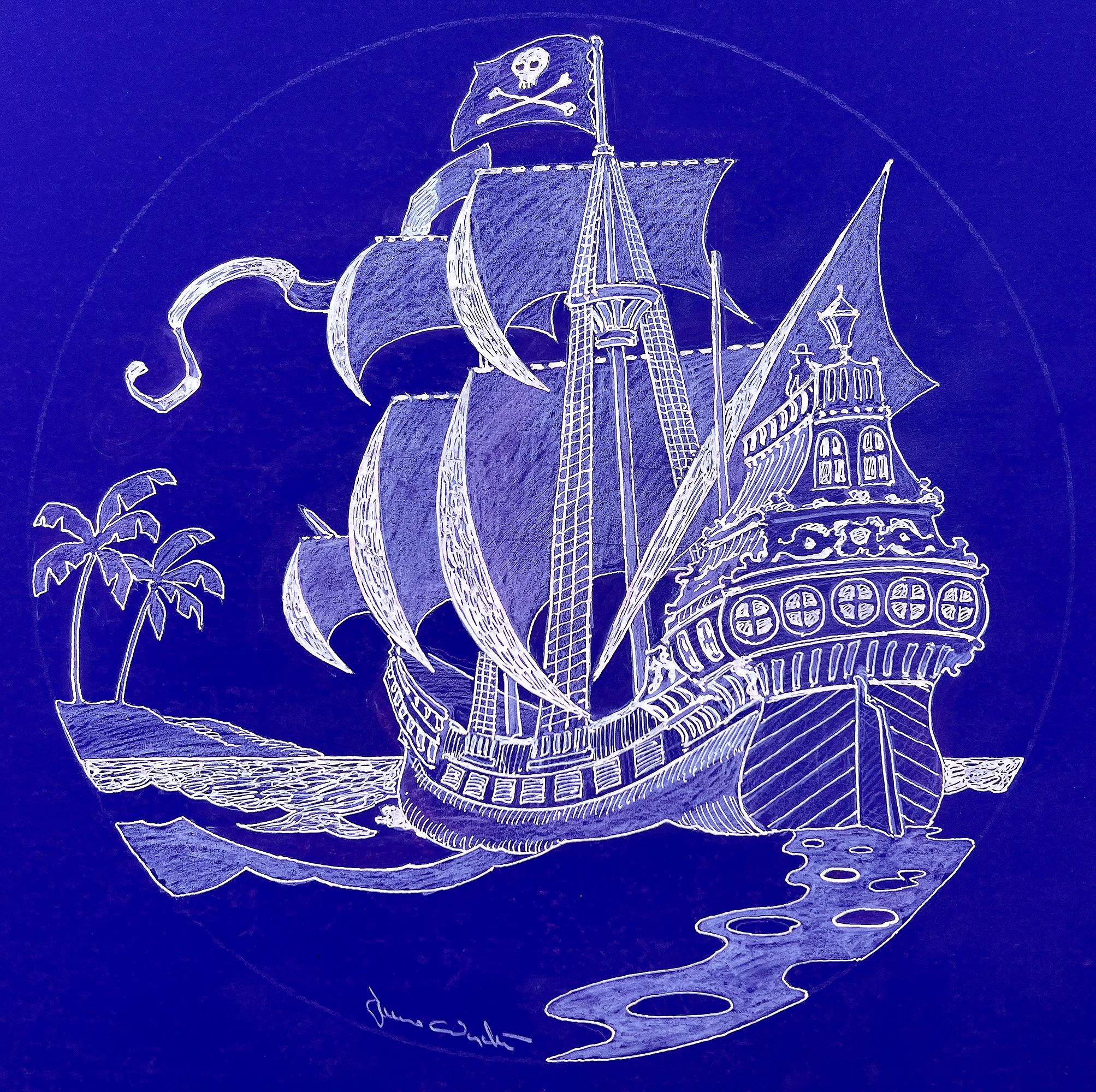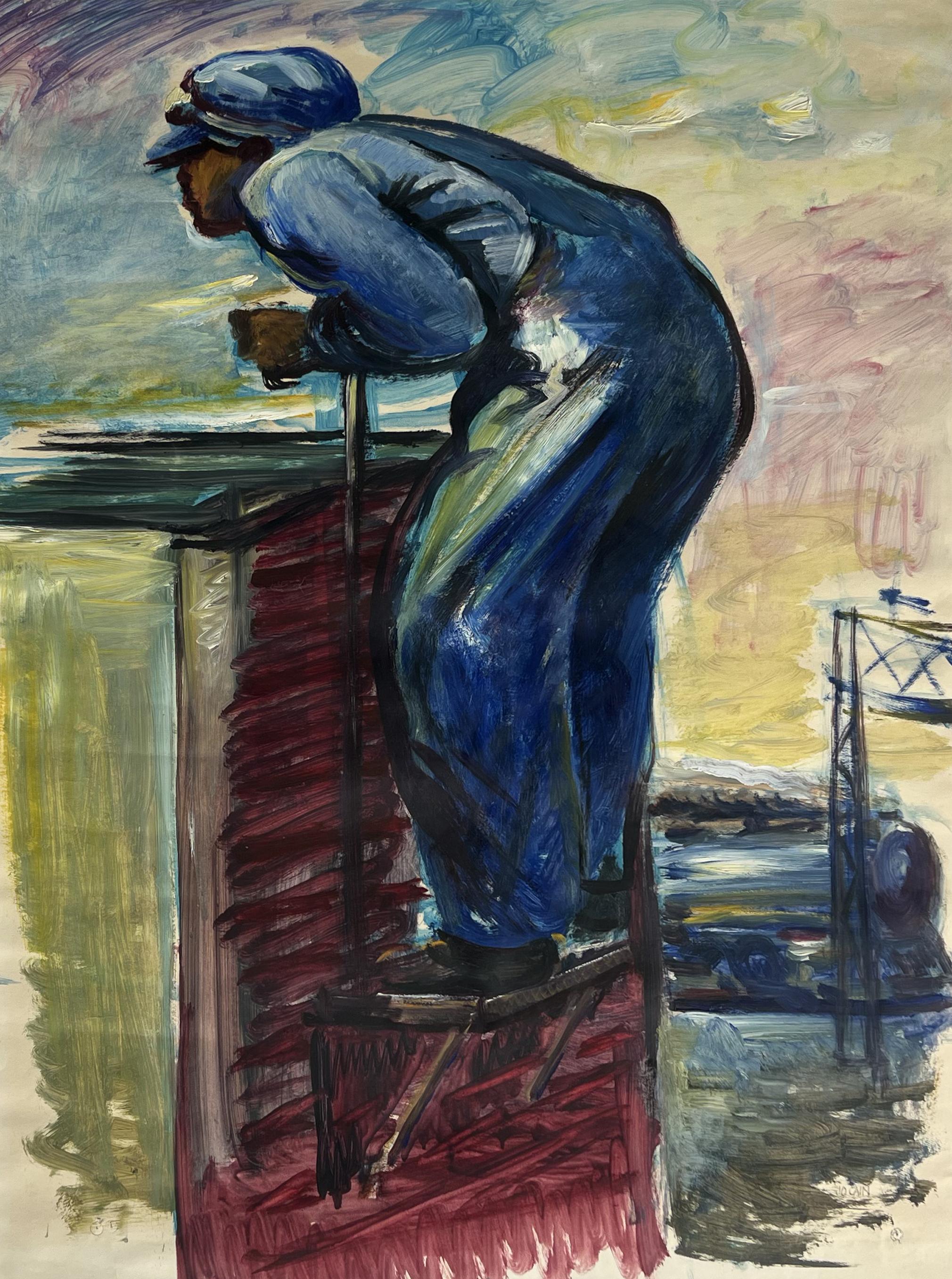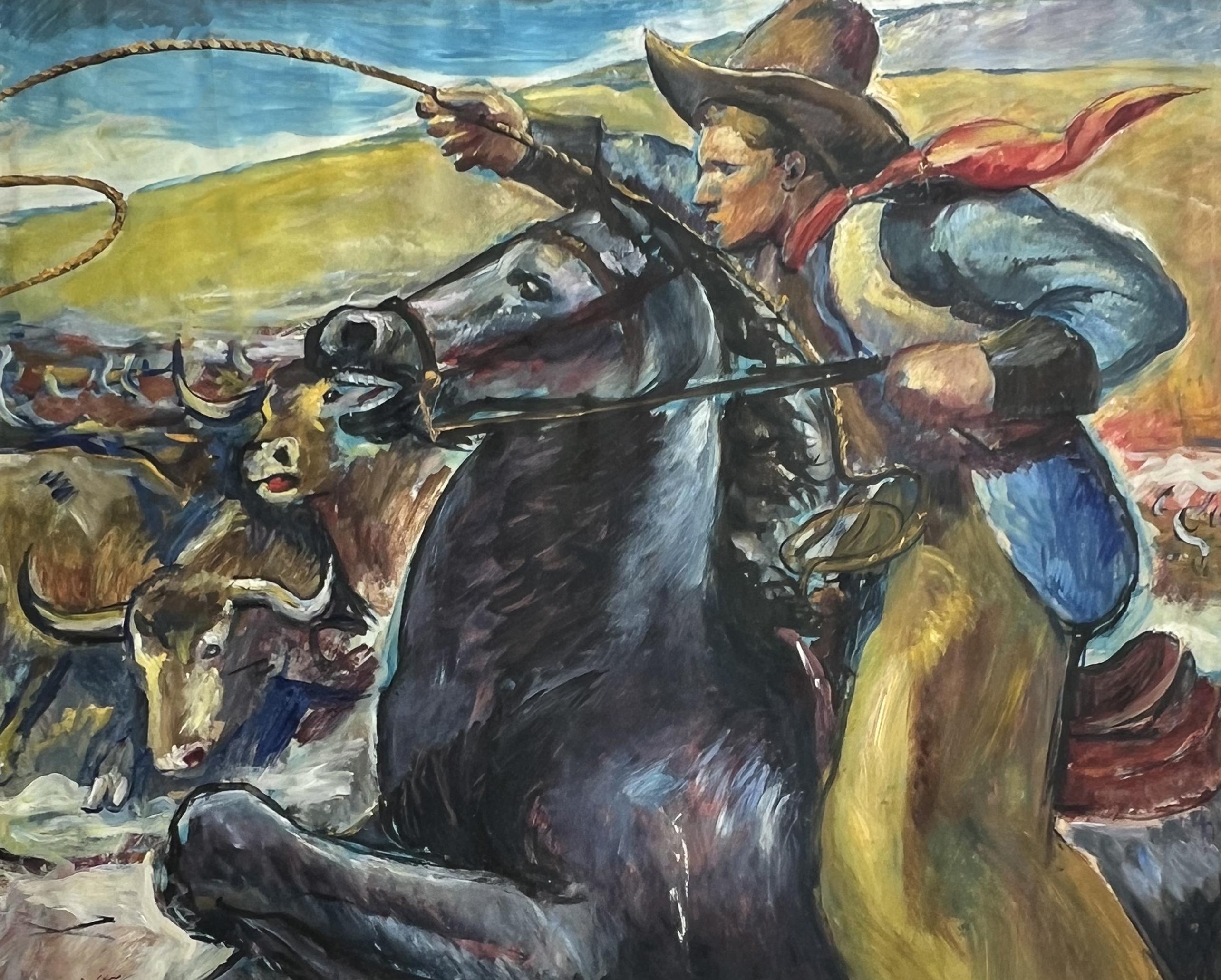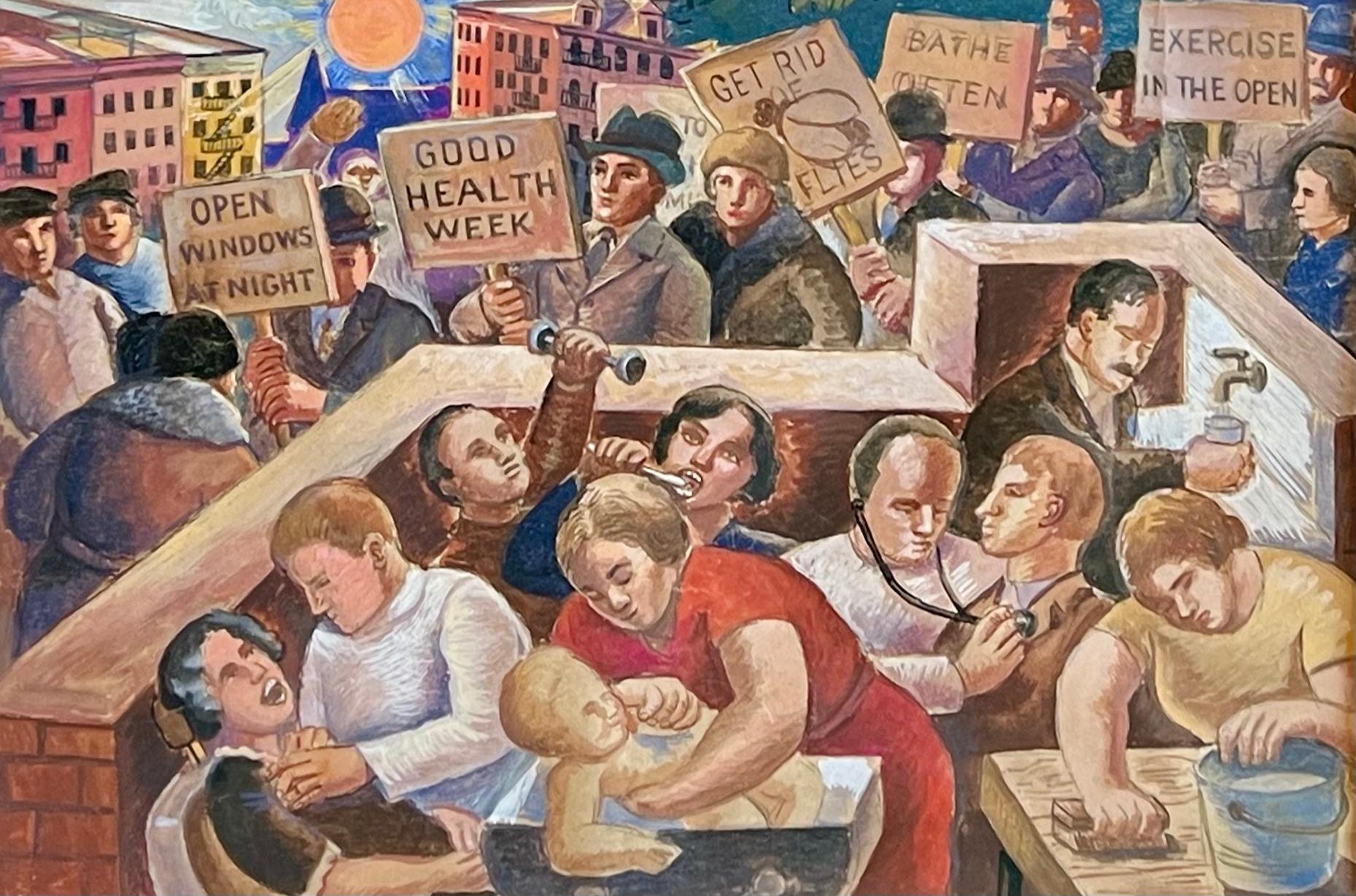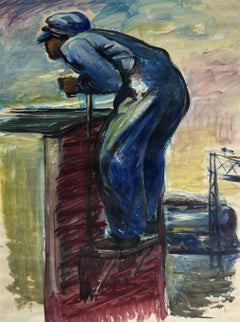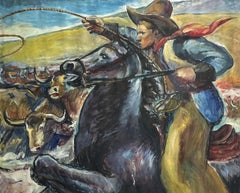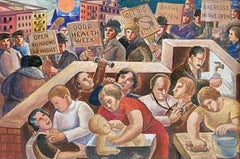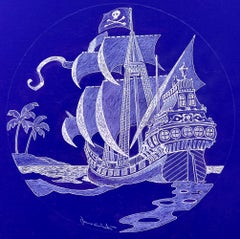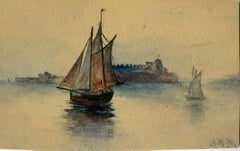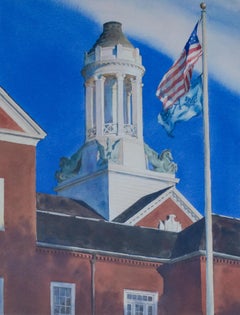Items Similar to Greenwich Village NYC WPA Mid 20th Century American Scene Ashcan Modern Realism
Want more images or videos?
Request additional images or videos from the seller
1 of 8
alfred miraGreenwich Village NYC WPA Mid 20th Century American Scene Ashcan Modern Realismc. 1930s
c. 1930s
About the Item
Greenwich Village NYC WPA Mid 20th Century American Scene Ashcan Modern Realism
Alfred Mira (1900-1981)
Greenwich Village NYC
14 x 17 inches
Oil on board, c. 1930s
Signed lower right
26 1/2 x 30 framed
We are not certain of the exact location depicted in the painting. It could be where Greenwich meets West 13th Street or 11th Street. The site could also be Seventh, Greenwich and West 11th, across from where St Vincent’s used to be. The tower in the right hand corner looks like the top of the (now) Jefferson Square Library. Those spots claim to be the diner in Hopper’s “Nighthawks."
BIO - in the artist's words
My boyhood days were spent between school and my father's carpentry shop. My interest in both these fields was overshadowed by my insatiable desire to draw. The books from which I was to learn my reading, writing and arithmetic were cluttered with pictures I had drawn on every available blank space. This aroused the wrath of my teachers who showed their unfriendliness. I believe I was allowed to graduate, not because I was an astute student, but because of their desire to be rid of me.
I embarked on my studies by obtaining a Job at an interior decorator's studio. My wish, however, was to go to an art school but this was impossible because my parents felt that a fifty-cent daily expenditure was an extravagance for a hobby in which they there was no future. My Salary at the studio was $3.00 a week, which my father granted me the right to save.
In 1919 I entered the National Academy of Design. My saving soon dwindled, so I left school and went back to work. I found employment in a Mural Art Studio. When time permitted, I attended the studio class at Beaux Arts School. After three years, I again matriculated at the National Academy in Ivan Olinsky's class.
At every opportunity I went outdoors to paint. My friends suggested that I have a studio exhibition with these studies and to my surprise, I sold almost all, so I planned to go to California where the climate and color were most suitable for my purpose. I was joined by a fellow student in this trip, who suggested we hitchhike our way to the coast so that we could stop here and there to paint. So we started our journey. We took the ferry to New Jersey and from there on we exercised our thumbs. One of our "lifters" suggested that we go via Detroit and stop there to paint the portraits of his parents. This was my first commission, and I need not say that I was filled with anxiety and fear. The results of this work brought several other portraits. After a few months, I became so absorbed in my work that I had completely forgotten about California. By this time my companion had become homesick and he induced me to return with him.
In 1926, with the money I had earned, I was able to have a good skylight studio, and there I set on a career of earning a living with painting, at the same time attending the studio class at the Art Students League.
The lure of the outdoors always attracted me, especially the city streets with their movements, color and depth-they were the things that inspired me and which I painted as they looked and as I felt them. Judging by my style and subjects, my artist friends argued that I was influenced by French Impressionists. While I bare great esteem for the French Masters, I do not claim comparison with them. However, my ultimate goal is to paint exclusively American Impressionism.
In 1928, my adventurous spirit took hold of me again and I went to Europe. I arrived in Paris and found that the gay life was not conducive to constructive work, so I went to South France with its sunny skies and mild climate where I was able to accomplish more. After traveling throughout the continent, I was awakened to the realization that the work I had done in Europe did not serve my purposes, and that I was better inspired in Washington Square.
Back home in New York, I devoted myself to painting street scenes. In 1929, my first effort to exhibit one of my street scenes was at the National Academy. The critics received this very kindly and I was so encouraged that I attempted other national exhibits that have flattered me in accepting every one of my paintings.
- Creator:alfred mira (1900 - 1981, American)
- Creation Year:c. 1930s
- Dimensions:Height: 26.5 in (67.31 cm)Width: 30 in (76.2 cm)
- Medium:
- Movement & Style:
- Period:
- Condition:
- Gallery Location:New York, NY
- Reference Number:1stDibs: LU1156212698582
About the Seller
5.0
Platinum Seller
Premium sellers with a 4.7+ rating and 24-hour response times
Established in 2008
1stDibs seller since 2019
189 sales on 1stDibs
Typical response time: <1 hour
- ShippingRetrieving quote...Shipping from: Pawling, NY
- Return Policy
Authenticity Guarantee
In the unlikely event there’s an issue with an item’s authenticity, contact us within 1 year for a full refund. DetailsMoney-Back Guarantee
If your item is not as described, is damaged in transit, or does not arrive, contact us within 7 days for a full refund. Details24-Hour Cancellation
You have a 24-hour grace period in which to reconsider your purchase, with no questions asked.Vetted Professional Sellers
Our world-class sellers must adhere to strict standards for service and quality, maintaining the integrity of our listings.Price-Match Guarantee
If you find that a seller listed the same item for a lower price elsewhere, we’ll match it.Trusted Global Delivery
Our best-in-class carrier network provides specialized shipping options worldwide, including custom delivery.More From This Seller
View AllAmerican Scene Social Realism Mid-20th Century WPA Era Woman Artist Children
Located in New York, NY
American Scene Social Realism Mid-20th Century WPA Era Woman Artist Children
Winnie Borne Sherman (1902-2004)
“Ring around the Rosie”
Pencil on Paperboard, c. 1930s
13 3/8 H x 15 5...
Category
1930s American Realist Figurative Drawings and Watercolors
Materials
Graphite, Board
Railroad Worker Industrial WPA American Scene Mid Century Modern Social Realism
By Jo Cain
Located in New York, NY
Railroad Worker Industrial WPA American Scene Mid Century Modern Social Realism
Jo Cain (1904 - 2003)
Railroad worker
36 ¼ x 27 inches
Oil on paper c. 1930s
S...
Category
1930s American Realist Figurative Drawings and Watercolors
Materials
Paper, Oil
Cowboys Horses Cattle WPA American Scene Social Realism Mid 20th Century Modern
By Jo Cain
Located in New York, NY
Cowboys Horses Cattle WPA American Scene Social Realism Mid 20th Century Modern
Jo Cain (1904 – 2003)
Cowboy
33 3/4 x 36 inches
Oil on paper, c. 1930s
Signed...
Category
1930s American Realist Figurative Drawings and Watercolors
Materials
Paper, Oil
"Good Health Week" WPA American Scene Mid 20th Century Modern Social Realism
By Jo Cain
Located in New York, NY
"Good Health Week" WPA American Scene Mid 20th Century Modern Social Realism
Jo Cain (1904 – 2003)
Good Health Week
10 ½ x 15 1/2 inches
Oil on pape...
Category
1940s American Realist Figurative Drawings and Watercolors
Materials
Paper, Oil
"Going to the Festival" WPA Ashcan 20th Century American Scene Modern Realism
By Daniel Ralph Celentano
Located in New York, NY
"Going to the Festival" WPA Ashcan 20th Century American Scene Modern Realism
Daniel Celentano (1902 - 1980) "Going to the Festival," 14 1/2 x 10 1/2. Watercolor on paper, c. 1930s....
Category
1930s American Realist Figurative Drawings and Watercolors
Materials
Paper, Watercolor
TOBACCO ROAD Mid 20th Century Realism 1940 Drawing from the Novel WPA Literary 3
By David Fredenthal
Located in New York, NY
TOBACCO ROAD Mid 20th Century Realism 1940 Drawing from the Novel WPA Literary 3
10 1/2 x 6 (sight), Signed David Fredenthal lower right. Framed by Lowy.
Offered here is one of several original drawings by WPA artist David Fredenthal that were first published in the 1940 illustrated edition of the novel TOBACCO ROAD by Erskine Caldwell.
Background on the Drawing
Erskine Caldwell remarked, on seeing the work of David Fredenthal, 26-year-old painter: "That boy could draw my Tobacco Road people." A casual comment, it was enormously productive.
The young painter was just finishing a two-year Guggenhcim Fellowship, preceded by a year's study in Paris, two one-man shows at New York's Downtown Gallery, and a fellowship at the Cranbrook Academy near Detroit. He was out in Colorado Springs when he heard what Caldwell had said about him.
Fredenthal hadn't read Tobacco Road. He had not even seen the play - now breaking all records in its seventh year on Broadway. But he swapped a portrait for a second-hand Ford and headed East.
In New York he learned that Dnell, Sloan & Pearce were bringing out a deluxe edition of Tobacco Road. But he had no entrée to the publishers, and Caldwell, to his disappointment, was out of town. So he drove on to Georgia to have a look at the Tobacco Road people.
He found Dr. I. C. Caldwell, the author's father, in Wrens, Ga., going on his ministerial rounds among people like the Lesters. Fredenthal got a room from a couple who ran a 1-pump filling station...
Category
1930s American Realist Figurative Drawings and Watercolors
Materials
Paper, Ink, Watercolor
You May Also Like
Environmental Prognostication Coil Narrative "Homo Sapiens R.I.P."
Located in Miami, FL
"They paved paradise and put up a parking lot," Joni Mitchell said. - - Created in 1969, at the dawn of the American environmental movement, artist Richard Erdoes draws a sequential narrative in the form of a coil. From inception to destruction, it illustrates a list of things that humans are doing to destroy the world we live in. The work was commissioned for school-age humans and executed in a whimsically comic way. Yet the underlying narrative is sophisticated and foreshadows a world that could be on the brink of ecological disaster.
Graphically and conceptually, this work exhibits an endless amount of creativity and Erdoes cartoony style is one to fall in love with.
Signed lower right. Unframed 12.4 inches Width: 12.85 inches Height is the live area. Board is 16x22 inches.
Richard Erdoes (Hungarian Erdős, German Erdös; July 7, 1912 – July 16, 2008) was an American artist, photographer, illustrator and author.
Early life
Erdoes was born in Frankfurt,to Maria Josefa Schrom on July 7, 1912. His father, Richárd Erdős Sr., was a Jewish Hungarian opera singer who had died a few weeks earlier in Budapest on June 9, 1912.After his birth, his mother lived with her sister, the Viennese actress Leopoldine ("Poldi") Sangora,He described himself as "equal parts Austrian, Hungarian and German, as well as equal parts Catholic, Protestant and Jew..."[4]
Career
He was a student at the Berlin Academy of Art in 1933, when Adolf Hitler came to power. He was involved in a small underground paper where he published anti-Hitler political cartoons which attracted the attention of the Nazi regime. He fled Germany with a price on his head. Back in Vienna, he continued his training at the Kunstgewerbeschule, now the University of Applied Arts, Vienna.[5] He also wrote and illustrated children's books and worked as a caricaturist for Tag and Stunde, anti-Nazi newspapers. After the Anschluss of Austria in 1938 he fled again, first to Paris, where he studied at the Academie de la Grande Chaumiere, and then London, England before journeying to the United States. He married his first wife, fellow artist Elsie Schulhof (d. xxxx) in London, shortly before their arrival in New York City.
In New York City, Erdoes enjoyed a long career as a commercial artist, and was known for his highly detailed, whimsical drawings. He created illustrations for such magazines as Stage, Fortune, Pageant, Gourmet, Harper's Bazaar, Sports Illustrated, The New York Times, Time, National Geographic and Life Magazine, where he met his second wife, Jean Sternbergh (d. 1995) who was an art director there. The couple married in 1951 and had three children.[6] Erdoes also illustrated many children's books.
An assignment for Life in 1967 took Erdoes to the Pine Ridge Indian Reservation for the first time, and marked the beginning of the work for which he would be best known. Erdoes was fascinated by Native American culture, outraged at the conditions on the reservation and deeply moved by the Civil Rights Movement that was raging at the time. He wrote histories, collections of Native American stories...
Category
1960s American Realist Landscape Drawings and Watercolors
Materials
Ink, Gouache, Illustration Board
Pirate Ship - Skull-and-Crossbones Seven Seas Illustration in White and Blue
By Jamie Wyeth
Located in Miami, FL
The Skull-and-Crossbones flag flies atop this illustration of a Pirate Ship. Two palm trees flank it, and it floats in a cropped stylized sea. A single hatted figure is seen looking ...
Category
1970s American Realist Landscape Drawings and Watercolors
Materials
Pastel, Ink, Board
Schooners along the Hudson, West Point Academy in the distance.
Located in Middletown, NY
A serene Hudson River scene by a student of Louis Comfort Tiffany.
Anna May Walling was born in 1881, a native of Goshen, New York. She was a graduate of the Blair Academy, and Prat...
Category
Early 20th Century American Realist Landscape Drawings and Watercolors
Materials
Watercolor, Handmade Paper
David Dewey Watercolor of Reader's Digest Headquarters
By David Dewey
Located in New York, NY
David Dewey (B. 1946)
Reader's Digest Headquarters, 1996
Watercolor on paper
Sight: 24 x 18 1/2 in.
Framed: 36 x 29 3/4 x 1 in.
Living on the Maine coast, David Dewey is a watercolo...
Category
1990s American Realist Landscape Drawings and Watercolors
Materials
Paper, Watercolor
Schooner St. Croix
By Emilio Sanchez
Located in New York, NY
Emilio Sanchez (1921-1999) created the watercolor entitled “Schooner St. Croix” in 1952. This piece is signed in pen at the lower right and titled on the verso. The paper size is 16.88 x 22.25 inches. Stamped on verso "Estate of Emilio Sanchez." Good to very good condition.
“Best known for his architectural paintings and lithographs, Emilio Sanchez (1921-1999) explored the effects of light and shadow to emphasize the abstract geometry of his subjects. His artwork encompasses his Cuban heritage...
Category
1950s American Realist Landscape Drawings and Watercolors
Materials
Graphite, Watercolor
Medicine Man
By Cassilly Adams
Located in Missouri, MO
Cassilly Adams (American 1843-1921)
"Medicine Man" c. 1860s
Watercolor on Paper
Unsigned
Provenance: Questroyal Gallery, NYC
Site Size: approx. 14.5 x 8....
Category
Mid-19th Century American Realist Figurative Drawings and Watercolors
Materials
Paper, Watercolor
Price Upon Request
Recently Viewed
View AllMore Ways To Browse
Scenes From Vintage America
American Realism Art
20th Century Realism Art
French Realism
Landscape American Realism
Mid Century Nyc
California Realism
Nyc Scene Art
Modern American Street Scene
Vintage Nyc Street Sign
20th Century Modern Realism
Watercolor Village Scene
Greenwich Paintings
20th Century American Realism
Realism Painting Mid Century
Nyc Realist
Mid Century Art Nyc
Realist Nyc Paintings

